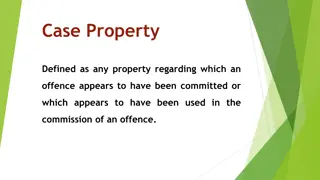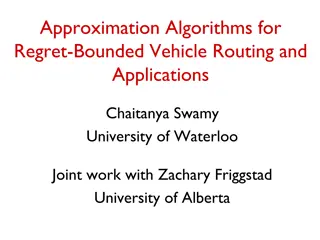Full Depth Reclamation (FDR) using Cement Stabilization and Additive
The procedure of selecting representative samples for the Job Mix Formula Design in Full Depth Reclamation (FDR) using Cement Stabilization and Additive. Understand the important principles and steps involved in sample collection.
6 views • 20 slides
Accelerating Additive Manufacturing Certification with Model-Based Tools
Mallory S. James, an Engineer at NASA Marshall Space Flight Center, explores qualification methodologies for AM spaceflight hardware. She focuses on model-based tools for accelerated AM certification and continuous process improvement. The IMQCAM Institute aims to innovate a model-centric workflow b
5 views • 16 slides
Understanding the Rule of Mixtures in Composite Materials
The Rule of Mixtures (ROM) is a weighted method for predicting the properties of composite materials, such as fiber-reinforced polymers (FRP). This method relies on assumptions regarding the homogeneity and properties of fibers and matrices. By combining volume fraction and properties linearly, the
5 views • 23 slides
Understanding Saponin Glycosides in Pharmacognosy: Properties and Applications
Saponin glycosides, found in various plants, are compounds with diverse benefits ranging from cholesterol regulation to potential anticancer properties. They form colloidal solutions in water and are used in soap manufacturing due to their unique properties. Additionally, saponins have bitter taste,
7 views • 18 slides
Understanding Properties and States of Matter in Physical Science
Matter is made up of elements that cannot be broken down further. Different mixtures have distinct properties, such as solutions, colloids, and suspensions. Physical properties like viscosity and density can be observed without changing the material's composition. Chemical properties, like flammabil
2 views • 15 slides
Generalized Additive Models
Generalized Additive Models (GAMs) provide a flexible and automatic statistical method for identifying and characterizing nonlinear regression effects. Unlike traditional linear models, GAMs can capture non-linear relationships between predictors and outcomes using unspecified smooth functions. By f
0 views • 52 slides
Additive Manufacturing Market
The growth of the additive manufacturing market is driven by the rising need to produce complex parts, reduce manufacturing expenses, and minimize waste, improvements in product development and supply chains, and easy customization and bulk production using additive manufacturing. However, the restr
1 views • 4 slides
Additive Manufacturing
additive manufacturing market is poised to soar to unprecedented heights, anticipated to burgeon to a monumental $228.8 billion by the year 2031, exhibiting a remarkable Compound Annual Growth Rate (CAGR) of 27.9% from 2024 to 2031.
1 views • 3 slides
South East Asia Collagen
Collagen, with its unique properties, has been extensively used in food processing industries. These properties are usually categorized into two groups. First, the properties associated with its gelling behavior, such as texturizing, thickening, gel formation, and water binding capacity, and second,
0 views • 2 slides
Additive Manufacturing
the growing use of 3D printers to produce functional end-use parts and composite 3D printing is expected to offer significant growth opportunities for players operating in the additive manufacturing market.
1 views • 3 slides
Additive Manufacturing
The growing use of 3D printers to produce functional end-use parts and composite 3D printing is expected to offer significant growth opportunities for players operating in the additive manufacturing market.
1 views • 3 slides
A Unified Approach to Interpreting Model Predictions
Unified methodology for interpreting model predictions through additive explanations and Shapley values. It discusses the relationship between Additive Explanations and LIME, introduces Shapley values, approximations, experiments, and extensions in model interpretation. The approach unifies various
1 views • 21 slides
Guidelines for Handling Case Properties and Seized Assets in Legal Proceedings
This informative content discusses the handling of case properties involved in offenses, including seizure, custody, disposal, and coordination among government departments. It covers various aspects such as the types of case properties, custody procedures, provisions under Section 516-A Cr.PC, and
0 views • 8 slides
Understanding Furan and Thiophene: Structures, Properties, and Uses
Furan and Thiophene are important heterocyclic organic compounds with distinct structures and properties. Furan, a five-membered aromatic ring, is used in specialty chemical production and has unique physical properties. Thiophene, a sulfur-containing compound, finds applications in agrochemicals an
2 views • 8 slides
Classification of Elements and Periodicity in Properties: Overview and Evolution
The journey of understanding the classification of elements and periodicity in properties begins with early laws like the Law of Triads and Newland's Law of Octaves. Mendeleev's Periodic Law revolutionized the organization of elements, leading to the modern periodic table. Discoveries of eka-alumini
3 views • 32 slides
Understanding Physicochemical Properties of Drugs
The physicochemical properties of drugs play a crucial role in their pharmacological effects. These properties include physical and chemical characteristics that influence interactions with biomolecules. Solubility, partition coefficient, and dissociation constant are key factors affecting drug beha
1 views • 46 slides
Algebra Rules and Properties
Explore the fundamental rules and properties of algebra and indices, including commutative, associative, and distributive properties. Learn about negation, zero properties, and the zero factor property, illustrated with examples and common errors. Engage in activities to apply and test your understa
1 views • 21 slides
Understanding Physical and Chemical Properties of Matter
Explore the distinction between physical and chemical properties of matter in Chapter 2, Section 2. Physical properties can be observed without changing the substance's identity, such as color and density, while chemical properties require altering the substance to observe characteristics like react
5 views • 20 slides
Understanding Selection Strategies in Animal Genetics and Breeding
Genes influence traits through Additive Gene Action (AGA) and Non-Additive Gene Action (NAGA) in animal breeding. Recurrent Selection (RS) and Reciprocal Recurrent Selection (RRS) play crucial roles in improving animals. Selection for General Combining Ability (GCA) and Specific Combining Ability (S
0 views • 16 slides
Understanding Nonelectrolytes in Solutions
Physical properties of substances are classified into colligative, additive, and constitutive properties. Colligative properties depend on the number of particles in a solution and are similar for different nonelectrolytes. Additive properties are based on the total contribution of atoms, while cons
1 views • 14 slides
Multi-Optimization of Empirical Models for Material Extrusion Process
Increased demand in the manufacturing industry has led to a focus on Additive Manufacturing (AM) tools and techniques. This study explores the optimization of material extrusion process parameters to enhance performance measures, addressing challenges such as print speed, accuracy, and mechanical pr
0 views • 17 slides
Understanding Rational Numbers: A Comprehensive Overview
Discover the world of numbers with this comprehensive guide on different types of numbers, focusing on rational numbers. Learn about natural numbers, whole numbers, integers, and how rational numbers are represented on a number line. Dive into the properties of rational numbers and explore the conce
2 views • 19 slides
Nottingham's Number Fluency Project - Ten-Frame Visualisation for Additive Facts
Explore the Nottinghams Number Fluency Project's innovative method of teaching additive facts using ten-frame visualizations. From basic additions like 1 + 1 = 2 to more complex sums, this project provides engaging visual aids to enhance number fluency and mathematical understanding.
0 views • 92 slides
Exploring Additive Manufacturing: A Revolutionary Technology
Additive manufacturing, commonly known as 3D printing, has witnessed significant advancements since its inception in the 1980s. This technology allows for the creation of three-dimensional objects through various processes like extrusion, binding, and polymerization. With the rise of accessible 3D p
3 views • 14 slides
Additive Combinatorics Approach to Log-Rank Conjecture in Communication Complexity
This research explores an additive combinatorics approach to the log-rank conjecture in communication complexity, addressing the maximum total bits sent on worst-case inputs and known bounds. It discusses the Polynomial Freiman-Ruzsa Conjecture and Approximate Duality, highlighting technical contrib
0 views • 9 slides
Understanding Physical and Chemical Properties of Matter
Explore the distinction between physical and chemical properties of matter in Chapter 15, Section 2. Learn to classify properties such as color, flammability, odor, shape, taste, density, and more. Understand how physical properties can be observed without altering the substance's identity, while ch
0 views • 17 slides
additive manufacturing
Additive manufacturing also enables the digital storage and on-demand production of spare parts, reducing the need for extensive inventory storage and ensuring the availability of parts for older or low-volume products.
1 views • 4 slides
Understanding Additive Angle Measures
In this lesson on additive angle measures, students learn how to find missing angle measures when two non-overlapping angles combine to form a larger angle. Essential questions are posed, and students are guided through solving problems involving angle decomposition and measurement. Practical activi
0 views • 46 slides
New Extension of the Weil Bound for Character Sums
Tali Kaufman and Shachar Lovett present a new extension of the Weil bound for character sums, providing applications to coding theory. The Weil bound offers insights into the behavior of low-degree polynomials, distinguishing between structured and random-like functions. This extension has implicati
0 views • 28 slides
Regret-Bounded Vehicle Routing Approximation Algorithms
Regret-bounded vehicle routing problems aim to minimize client delays by considering client-centric views and bounded client regret measures. This involves measuring waiting times relative to shortest-path distances from the starting depot. Additive and multiplicative regret measures are used to add
0 views • 28 slides
European Union Industrial Strategy and Additive Manufacturing
The EU's industrial strategy focuses on enhancing the resilience of industrial ecosystems through additive manufacturing. The manufacturing industry in Europe is a vital driver of employment, innovation, and prosperity. Despite being a front runner in metal and hybrid 3D printing, the EU faces chall
0 views • 6 slides
Enhancing Engine Performance with Nano-additive in Oil: A Study on Heat Transfer
Investigate the impact of mixing nano-additive with engine oil on heat transfer performance in a study conducted by Team 8. The project aims to design a radiator and oil-coolant system for a spark ignition engine, exploring the benefits of using nano-particles in enhancing heat transfer rates. Addre
0 views • 27 slides
Innovative Modeling and Monitoring in Additive Manufacturing at MOEMS Laboratory
Distinguished Professor Yu-Lung Lo from National Cheng Kung University's Department of Mechanical Engineering leads research on modeling and process monitoring for additive manufacturing. The laboratory focuses on challenges such as electron beam acceleration, simulation models, and optimal paramete
0 views • 15 slides
Approximation Algorithms for Regret-Bounded Vehicle Routing
This research explores regret-bounded vehicle routing problems (VRPs) where the focus is on minimizing client delays based on their distances from the starting depot. The study introduces a client-centric view to measure regret and devises algorithms for both additive and multiplicative regret-based
0 views • 23 slides
Understanding Transitivity of Properties in Typed Systems
Exploring the concept of transitivity in properties within a typed system, this content delves into explicit and possibly transitive properties, showcasing how properties relate to each other and how they can be implicitly or explicitly defined. Through examples and explanations, the content provide
0 views • 18 slides
Understanding Negative Numbers and Additive Inverse
Explore the world of negative numbers and additive inverse through a series of mathematical exercises. Learn how to calculate sums involving negatives and discover the concept of additive inverses, where adding a number and its opposite results in zero. Test your understanding with various numerical
0 views • 21 slides
Side Channel Monitoring in Additive Manufacturing for Cybersecurity and Quality Assurance
Side channel monitoring is crucial in the field of additive manufacturing to bridge cybersecurity and quality assurance. This process involves detecting physical domain data leakage through various side channels like acoustics, thermal, laser, vibration, electric current, optical, and pressure. By m
0 views • 10 slides
Overview of Color Models in Computer Graphics
Color models in computer graphics play a crucial role in creating a wide range of colors using a limited set of primary colors. There are two main types of color models - additive and subtractive, with RGB being common for displays and CMYK for printing. RGB is additive, combining red, green, and bl
0 views • 16 slides
Entity-specific Rankings of Knowledge Base Properties
Towards entity-specific rankings of knowledge base properties, this research explores the problem of property ranking for entities based on their attributes and properties. Various applications in knowledge base curation and natural language generation are discussed, along with related work in entit
0 views • 26 slides
Understanding Additive Alternates in ODOT Contracts
Exploring the role of Additive Alternates in ODOT construction projects, including why they are essential, how they are set up, awarded, and considerations for the future. Additive Alternates provide flexibility in project funding and scope, allowing owners to add extra work within budget constraint
0 views • 8 slides







































